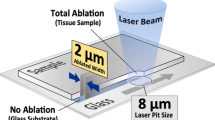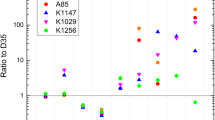Abstract
Bone may be similar to geological formulations in many ways. Therefore, it may be logical to apply laser-based geological techniques in bone research. The mineral and element oxide composition of bioapatite can be estimated by mathematical models. Laser-induced plasma spectrometry (LIPS) has long been used in geology. This method may provide a possibility to determine the composition and concentration of element oxides forming the inorganic part of bones. In this study, we wished to standardize the LIPS technique and use mathematical calculations and models in order to determine CaO distribution and bone homogeneity using bovine shin bone samples. We used polished slices of five bovine shin bones. A portable LIPS instrument using high-power Nd++YAG laser pulses has been developed (OpLab, Budapest). Analysis of CaO distribution was carried out in a 10 × 10 sampling matrix applying 300-μm sampling intervals. We assessed both cortical and trabecular bone areas. Regions of interest (ROI) were determined under microscope. CaO peaks were identified in the 200–500 nm wavelength range. A mathematical formula was used to calculate the element oxide composition (wt%) of inorganic bone. We also applied two accepted mathematical approaches, the Bartlett’s test and frequency distribution curve-based analysis, to determine the homogeneity of CaO distribution in bones. We were able to standardize the LIPS technique for bone research. CaO concentrations in the cortical and trabecular regions of B1–5 bones were 33.11 ± 3.99% (range 24.02–40.43%) and 27.60 ± 7.44% (range 3.58–39.51%), respectively. CaO concentrations highly corresponded to those routinely determined by ICP-OES. We were able to graphically demonstrate CaO distribution in both 2D and 3D. We also determined possible interrelations between laser-induced craters and bone structure units, which may reflect the bone structure and may influence the heterogeneity of CaO distributions. By using two different statistical methods, we could confirm if bone samples were homogeneous or not with respect to CaO concentration distribution. LIPS, a technique previously used in geology, may be included in bone research. Assessment of element oxide concentrations in the inorganic part of bone, as well as mathematical calculations may be useful to determine the content of CaO and other element oxides in bone, further analyze bone structure and homogeneity and possibly apply this research to normal, as well as diseased bones.



Similar content being viewed by others
References
Seeman E (2008) Bone quality: the material and structural basis of bone strength. J Bone Miner Metab 26(1):1–8
Skinner H (2013) Minerology of bone. In: Essentials of medical geology, Chapter 30, pp 665–685
Klein GL (2005) Aluminum: new recognition of an old problem. Curr Opin Pharmacol 5(6):637–640
Palacios C (2006) The role of nutrients in bone health, from a to Z. Crit Rev Food Sci Nutr 46(8):621–628
Malluche HH (2002) Aluminium and bone disease in chronic renal failure. Nephrol Dial Transplant 17(Suppl 2):21–24
Bervoets AR, Oste L, Behets GJ, Dams G, Blust R, Marynissen R, Geryl H, De Broe ME, D'Haese PC (2006) Development and reversibility of impaired mineralization associated with lanthanum carbonate treatment in chronic renal failure rats. Bone 38(6):803–810
Kazantzis G (2004) Cadmium, osteoporosis and calcium metabolism. Biometals 17(5):493–498
Shih RA, Hu H, Weisskopf MG, Schwartz BS (2007) Cumulative lead dose and cognitive function in adults: a review of studies that measured both blood lead and bone lead. Environ Health Perspect 115(3):483–492
Carmouche JJ, Puzas JE, Zhang X, Tiyapatanaputi P, Cory-Slechta DA, Gelein R, Zuscik M, Rosier RN, Boyce BF, O'Keefe RJ et al (2005) Lead exposure inhibits fracture healing and is associated with increased chondrogenesis, delay in cartilage mineralization, and a decrease in osteoprogenitor frequency. Environ Health Perspect 113(6):749–755
Mak TW, Shek CC, Chow CC, Wing YK, Lee S (1998) Effects of lithium therapy on bone mineral metabolism: a two-year prospective longitudinal study. J Clin Endocrinol Metab 83(11):3857–3859
Tannirandorn P, Epstein S (2000) Drug-induced bone loss. Osteoporos Int 11(8):637–659
Cohen O, Rais T, Lepkifker E, Vered I (1998) Lithium carbonate therapy is not a risk factor for osteoporosis. Horm Metab Res 30(9):594–597
Weinberg ED (2008) Role of iron in osteoporosis. Pediatr Endocrinol Rev 6(Suppl 1):81–85
Tapiero H, Tew KD (2003) Trace elements in human physiology and pathology: zinc and metallothioneins. Biomed Pharmacother 57(9):399–411
Lowe NM, Lowe NM, Fraser WD, Jackson MJ (2002) Is there a potential therapeutic value of copper and zinc for osteoporosis? Proc Nutr Soc 61(2):181–185
Kitchin B, Morgan SL (2007) Not just calcium and vitamin D: other nutritional considerations in osteoporosis. Curr Rheumatol Rep 9(1):85–92
Reginster JY (2007) Strontium ranlelate (Protelos). Rev Med Liege 62(11):685–687
Burlet N, Reginster JY (2006) Strontium ranelate: the first dual acting treatment for postmenopausal osteoporosis. Clin Orthop Relat Res 443:55–60
Ralston SH (2005) Bone densitometry and bone biopsy. Best Pract Res Clin Rheumatol 19(3):487–501
Griffith JF, Genant HK (2008) Bone mass and architecture determination: state of the art. Best Pract Res Clin Endocrinol Metab 22(5):737–764
D'Haese PC, Couttenye MM, Lamberts LV, Elseviers MM, Goodman WG, Schrooten I, Cabrera WE, De Broe ME (1999) Aluminum, iron, lead, cadmium, copper, zinc, chromium, magnesium, strontium, and calcium content in bone of end-stage renal failure patients. Clin Chem 45(9):1548–1556
Uryu T, Yoshinaga J, Yanagisawa Y, Endo M, Takahashi J (2003) Analysis of lead in tooth enamel by laser ablation-inductively coupled plasma-mass spectrometry. Anal Sci 19(10):1413–1416
Hetter KM, Bellis DJ, Geraghty C, Todd AC, Parsons PJ (2008) Development of candidate reference materials for the measurement of lead in bone. Anal Bioanal Chem 391(6):2011–2021
Liu G, Xie J, Liu X, Gao J (2002) Application of microwave dissolution and inductively coupled plasma-MS spectrometry for determination of ultra-trace level of lanthanides in human rib. Wei Sheng Yan Jiu 31(4):235–237
Raffalt AC, Andersen JE, Christgau S (2008) Application of inductively coupled plasma-mass spectrometry (ICP-MS) and quality assurance to study the incorporation of strontium into bone, bone marrow, and teeth of dogs after one month of treatment with strontium malonate. Anal Bioanal Chem 391(6):2199–2207
Shafer MM, Siker M, Overdier JT, Ramsl PC, Teschler-Nicola M, Farrell PM (2008) Enhanced methods for assessment of the trace element composition of iron age bone. Sci Total Environ 401(1–3):144–161
Radziemski LJ (1994) Review of selected analytical applications of laser plasmas and laser-ablation, 1987-1994. Microchem J 50(3):218–234
Maros G, Pasztor S (2001) New and oriented core evaluation method: ImaGeo. European Geologist 12:40–43
Maros G, Palotás K, Koroknai B, Sallay E (2002) Tectonic evaluation of borehole PTP-3 in the Krusné hory Mts. with ImaGeo mobile corescanner. Bull Czech Geol Surv 77:105–112
Maros G, Andrássy L, Zilahi-Sebes L, Máthé Z (2008) Modelling the boda aleurolite formation (BAF) based on core analyses using a laser-induced plasma spectrometer. First Break 26:143–154
Andrássy L, Zilahi-Sebess L, Vihar L (2003) Theoretical and statistical investigation of elemental concentration distributions determined by laser induced plasma atom emission spectra. Geophys Transact 44:95–138
Andrassy L, Maros G, Kovacs IJ, Horvath A, Gulyas K, Bertalan E, Besnyi A, Furi J, Fancsik T, Szekanecz Z et al (2014) Applicability of laser-based geological techniques in bone research: analysis of calcium oxide distribution in thin-cut animal bones. Orv Hetil 155(45):1783–1793
Bartlett M (1937) Properties of sufficiency and statistical tests. Proc Roy Stat Soc, Series A60(268–282)
Andrássy L, Maros G (2011) Statistical analysis of the distribution of element oxide concentrations measured by ImaGeo-LIPS in the boda siltstone formation. Magyar Geofizika (Hung Geophys) 52(2):62–79
Vincze I (1975) Mathematical statistics with industrial applications. Műszaki Könyvkiadó, Budapest
Acknowledgements
The authors would like to thank the Department of Laboratory Medicine at Faculty of Medicine of the University of Debrecen for carrying out the qCT tests and the staff of the Laboratory Department of the Geological and Geophysical Institute of Hungary (GGIH; namely István Kovács and Ferenc Fenesi) for the preparation of animal bone samples (thin sections) as well as for performing the ICP-OES assessment.
Funding
This research was supported by grant OTKA K105073 from the National Scientific Research Fund of Hungary (HPB and ZS) and by the European Union and the State of Hungary co-financed by the European Social Fund in the framework of TÁMOP-4.2.4.A/2-11/1-2012-0001 ‘National Excellence Program’ (ZS).
Author information
Authors and Affiliations
Corresponding author
Ethics declarations
Conflict of interest
The authors declare that they have no competing interests.
Ethical approval
This article does not contain any studies with human participants or live animals performed by any of the authors.
Rights and permissions
About this article
Cite this article
Andrássy, L., Gomez, I., Horváth, Á. et al. Laser-induced plasma spectroscopy (LIPS): use of a geological tool in assessing bone mineral content. Lasers Med Sci 33, 1225–1236 (2018). https://doi.org/10.1007/s10103-018-2462-4
Received:
Accepted:
Published:
Issue Date:
DOI: https://doi.org/10.1007/s10103-018-2462-4




